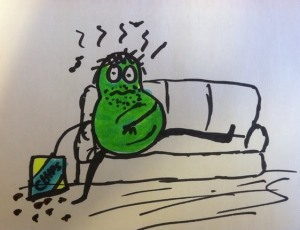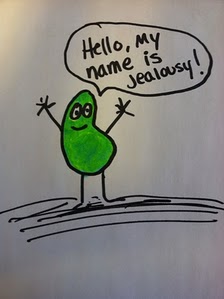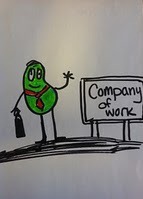I developed this little analogy to show the importance of dealing with our emotions and not just ignoring them. (As mentioned in my previous post- Guilty- Internal Struggle)
I dedicate this to my friend Jon who has been waiting so patiently for me to post this. Here you are my friend!
First, visualize your emotions as a small living thing.
See? They are cute! Why wouldn’t you want to spend time getting to know these little guys?
You can do one of two things with this cute little green guy. You can 1- ignore him or 2- deal with them.
Ignoring
What happens when you ignore these guys? Well, the neglected emotion does nothing. At. All. It sits there in your home, on your couch, probably watching tv, becoming a permanent fixture on your couch.
Eventually, it will get bigger in the waist and becomes a waste.
How could this situation be worse? Just imagine more than one little occupier … 2, 3, 4 …. Just add up the emotions you are ignoring. The feelings you push aside and don’t deal with. That’s one big mess and probably wouldn’t smell so good since I’m sure these little guys haven’t showered. Ick.
How many of us have emotional lives that are filled with these creatures? I will be the first to admit that I have a few in my life that I’m dying to get rid of. So what is the cure? How do we prevent this from happening, or how do we clean up the mess of delayed dealings?!
Dealing
Back to the beginning. You have this cute little creature, before he gets fat and joins the “occupy the couch” movement. You don’t want to end up with another couched emotion. So what do you do?
Acknowledge them. Give them a name.
I’ve said this before, naming the emotion makes it real. It does take some discernment on your part to determine what the emotion is and risk giving it the wrong name. Down the road we may have to change the name of the little guy and maybe it is necessary as the emotion changes as it gets put to work. How does your emotion work…
… give them a backpack and send them off to school!
Sometimes these emotions become so productive that they go off to college and never come back. They might keep in touch, but that might not always be the case. Is that a bad thing? It might be hard, we might miss them, but overall it’s better to have them out in the world rather than on the couch, taking up space.
Some of these emotions will come back after “college” and move in next door. You might be working through them the rest of your life. Does that mean you resent it? Maybe sometimes, but does that mean you let them become the trashy neighbors? No! Don’t give them the power to decrease your property value. Keep working on them.
Kicking off the couch
So what about the guys you have on your couch right now? Remember, it’s never too late to go back to school! Send them now. Clean them up, give them their name and give them a backpack! The only difference is you might not be giving them a Phineas and Ferb backpack.
I can’t help but think of Adam Sandler in Billy Madison singing, “Back to School, back to school…” Let your emotions prove to you that they are not fools! They can become working members of society.
****
This might sound silly, but I can honestly say that coming up with this little analogy has helped me deal with what’s going on in my life. It allows me to separately identify and analyze each different emotional thing going on in my head/heart. Instead of looking at a clump of dirty, smelly things, you can see them individually working on their different projects for school.
So why the backpack? The backpack gives the emotion a purpose. It is a needed tool for the work they have ahead of them. When we go to school we use a backpack to help carry our books and other tools of learning. You are working through the emotion and it is not fighting against you, but working with you.
You can’t expect your emotions to take care of themselves or just disappear! If you don’t stick a backpack on it and send it to school, no one else will.










